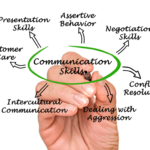The Power of Persuasive Communication: Mastering the Art for Effective Influence

The power of persuasive communication is undeniable.
In today's world, where information overload and short attention spans are the norm, mastering the art of effective influence is more important than ever.
Whether you're a marketer trying to sell a product, a leader trying to inspire your team, or an individual looking to make an impact, understanding the power of persuasive communication is the key to success.
In this article, we will explore the essential techniques and principles that can help you become a master persuader, allowing you to connect with your audience, build trust, and ultimately achieve your goals.
So, get ready to unlock the secrets of persuasive communication and unleash your power of influence.
Understanding Your Audience
Harnessing the power of persuasive communication can be greatly enhanced by comprehending your audience.
Taking into account their needs, interests, and values allows you to construct arguments and entreaties that are tailored to capture their attention and affect their decision-making.
No matter, if you are talking to a small group of colleagues or a large number of people, understanding your audience, can help you build a deeper rapport with them, foreseeing their issues and questions and providing your ideas in a mode that speaks to their special outlook.
When evaluating your audience, it is important to consider their demographics, such as age, gender, and cultural heritage. These factors can have a significant impact on how they perceive and decipher information.
Additionally, you should take into account their expertise and familiarity with the subject. Are they knowledgeable about the topic or do you need to provide more background data?
Comprehending their level of understanding allows you to find the right balance between simplicity and complexity in your communication.
Moreover, understanding your team goes beyond demographics and knowledge. It necessitates empathy and the capability to put yourself in their shoes.
What are their hopes, worries, and motivations? What are their pain points and obstacles?
By understanding their emotional landscape, you can tap into their emotions and establish a connection that resonates on a deeper level.
This connection not only captures their attention but also creates a sense of relatability and trust.
In conclusion, understanding your audience is a crucial piece of persuasive communication.
It allows you to customize your message to their requirements and interests, build trust and credibility, and form a bond that resonates emotionally.
By devoting time and effort to truly comprehending your audience, you can become a more capable influencer and reach your desired results.
So, take the time to research and analyze your audience before every communication opportunity, and witness as your influence and impact escalate.
Building Trust
Establishing trust is essential to the practice of persuasive communication. When seeking to influence others, creating a foundation of confidence between yourself and your intended listeners is of the utmost importance.
Trust enables messages to be taken in with an open mind, thus augmenting the chances of your concepts being accepted.
In order to construct trust, it is vital to be sincere and transparent in your speech.
Demonstrating that you have the best interests of your audience in mind and that you can be relied on is necessary.
Showing uprightness and constantly fulfilling your promises will help foster trust and reinforce the bond between you and your recipients.
Remember, forming a trust is a gradual process that takes time and effort, but it is a key component in becoming a master persuader.
When it comes to persuasive communication, invoking emotions is a potent tool for gaining trust.
Feelings have a profound influence on decision-making and can shape how your audience perceives your message.
By tapping into the emotions of your listeners, you can generate a sense of understanding and develop a connection that goes beyond mere logic and reasoning.
When people sense that they are comprehended and emotionally involved, they are more likely to have faith in your motives and be open to your ideas.
Nevertheless, it is important to use emotions ethically and responsibly, making sure that you are not manipulating or exploiting your audience's emotions for personal gain.
Building trust through emotional appeal necessitates empathy, authenticity, and a genuine comprehension of your audience's emotions.
Another successful strategy for forming a trust is utilizing social proof.
Individuals are inclined to trust the opinions and behavior of others, especially those they view as similar to themselves or as specialists in a particular field.
By displaying reviews, endorsements, or case studies that highlight the positive experiences and outcomes of people who have interacted with your ideas or products, you can inspire trust and assurance in your audience.
Social proof gives assurance and legitimization, demonstrating that your ideas have been tested and proven successful.
This can allay any uncertainty or cynicism your audience may have and enhance their willingness to trust and take your lead.
Keep in mind to choose social proof that is pertinent and reliable to your audience, as this will have a greater effect on building trust.
Fostering dialogue is an important aspect of building trust in persuasive communication.
It is essential to create an atmosphere where your audience feels at ease expressing their views, worries, and queries.
Appealing to Emotions
Making an emotional appeal is an effective way to engage with an audience while persuading them.
By understanding the emotional triggers of your listeners, you can craft your message to elicit the desired response.
By appealing to their emotions, you can establish a connection and make your statement more relatable.
From telling heartwarming stories to evoking empathy or generating enthusiasm, tapping into emotions can render your communication even more memorable and influential.
Striking the emotional chord can generate a sense of urgency and drive people to action. When individuals feel emotionally connected and invested in your message, they are more likely to be swayed by it.
Utilizing language that stirs strong emotions can captivate their attention and keep them engaged.
From employing striking imagery, and powerful metaphors, to relatable anecdotes, appealing to emotions can help you achieve lasting results.
Appealing to emotions is not about manipulating feelings, but rather about forging a deep connection. Doing so demonstrates that you comprehend their needs, desires, and worries.
By leveraging emotions, you can establish trust and credibility, making your message more agreeable to the receiver.
Emotions can be a powerful propellant behind decision-making, and by capitalizing on this factor, you can influence the choices and actions of others.
Therefore, if you want to become an expert persuader, don't overlook the potency of appealing to emotions in your communication.
Employing social proof is a powerful technique in persuasive communication. Seeing that others have already hopped on board or had success with a particular concept or product can strongly influence people to follow suit.
Social proof can be displayed through customer reviews, testimonials, and case studies, displaying that others have gained from your message.
Showcasing the positive experiences of others can create a feeling of trustworthiness and credibility, making your communication more convincing.
When utilizing social proof, it is essential to pick examples that are pertinent to your audience and match their values and ambitions.
Influencers are a successful way to employ social proof. Influencers are people who have a significant following and can sway the opinions and behaviors of their followers.
By partnering with influencers who go along with your message and brand, you can take advantage of their credibility and social proof to enhance the persuasiveness of your communication.
When an influencer endorses your message or product, their audience members are more likely to trust and be influenced by your message.
This can be especially powerful in industries like fashion, beauty, and fitness, where influencers have a profound influence on customer behavior.
Data and Statistics are another way to employ social proof. People are more likely to be persuaded when they see evidence that your message has worked for others.
By showcasing data and statistics that demonstrate the positive impact of your message or product, you can provide social proof that your message is effective and reliable.
This can be done through surveys, research studies, or case studies that highlight the successful results of your message.
When utilizing social proof through data, it is important to make sure the data is precise, pertinent, and presented in a clear and convincing way.
Storytelling
Telling stories is a powerful weapon when it comes to manipulating people.
With this tactic, we can captivate and bond with our audience on a deeper level, stimulating their emotions and holding their attention.
Through compelling storytelling, we can effectively transmit our message and make it unforgettable. Storytelling helps us to paint an intense image and generate a feeling of understanding which can have a huge impact on other people's opinions and decisions.
It is with the skill of storytelling that we can truly utilize the power of influence and make a lasting impression.
Not only does storytelling enchant the public, but it also aids in establishing trust. By sharing personal stories or employing familiar examples, we show genuineness and candor.
By revealing our own experiences, we demonstrate vulnerability and relate to our listeners on a human level.
This strengthens trust and believability, making our message more convincing and influential.
When our audience confides in us, they are more likely to accept our ideas and be persuaded by our opinions.
Moreover, storytelling enables us to apply social proof in a subtle and successful way.
By narrating stories of others who have been positively swayed by our ideas or products, we provide evidence that our message is valid and worth taking into consideration.
When people witness that others have had positive consequences, they are more likely to follow suit and be influenced by our advice.
To sum up, storytelling is an essential element in the art of persuasive communication and effective influence.
By exploiting the strength of storytelling, we can engage our audience, construct trust, and utilize social proof to make our message more compelling.
Through storytelling, we can create a bond and appeal to the emotions of our audience, making our message more memorable and effective.
So, exploit the potency of storytelling and unlock your potential to become a master persuader.
Fostering Two-Way Communication
Mastering persuasive communication requires a mastery of two-way communication.
This involves establishing a dialogue between the persuader and the audience, allowing for the trading of ideas, perspectives, and reactions.
By encouraging open and transparent communication, the persuader can attain worthwhile knowledge of their audience's requirements and apprehensions, thus enabling them to craft an appropriate message.
This not only reinforces trust and reliability but also establishes a stronger bond between the persuader and the audience, making for a greater chance of successful persuasion.
In the art of persuasive communication, two-way communication means more than simply delivering a message.
It necessitates actively listening to the audience, acknowledging their ideas, and reacting suitably.
This builds a feeling of inclusion and respect, making the audience feel respected and heard.
By fostering a shared environment, the persuader can involve the audience in a meaningful dialogue, encouraging them to actively take part and contribute to the discourse.
This not only bolsters the overall effectiveness of persuasive communication but also offers a sense of ownership and control to the audience.
Moreover, two-way communication facilitates the discovery and resolution of any doubts or worries the audience may have.
By engaging with the audience, the persuader can confront their hesitations and supply relevant facts or proof to assuage their doubts.
This demonstrates transparency and genuineness, further boosting the persuader's reputation.
Furthermore, two-way communication enables the building of relationships and the development of a rapport with the audience, creating a trust-filled platform that is essential for an effective influence.
All in all, fostering two-way communication is a potent tool in the art of persuasive communication, allowing the persuader to interact with their audience on a deeper level and eventually attain their desired outcome.
The Art of Persuasion
Fostering persuasive communication is a skill that can be sharpened and perfected with the knowledge of the various tactics and rules essential to successful influence.
It involves comprehension of your target, establishing trust, appealing to emotions, using social evidence, narrating stories, and encouraging two-way dialogue.
These components are critical in creating effective messages and convincing others to take action. In our article, titled The Power of Persuasive Communication: Mastering the Art of Effective Influence, we explore the power of persuasive communication and how it can be leveraged to effectively influence others.
Through this exploration, readers can acquire useful ideas and techniques to refine their persuasive capabilities and become more influential in all kinds of situations.
Understanding and mastering the Art of Persuasion is a game-changer in terms of successful communication and leadership.
It is not only about what you voice but how you say it that matters.
By utilizing the principles of persuasion, individuals can become more capable persuaders and influencers.
In our article, we delve into the 10 essential principles of persuasion, unlocking the secrets to persuasive communication.
These principles, from comprehending your audience to utilizing storytelling techniques, offer a comprehensive guide to becoming a master persuader.
Whether you are a business specialist, or salesperson, or just want to advance your communication abilities, our article provides helpful insights and practical tips to enhance your persuasive abilities and make a lasting impression.
The Power of Influence
Captivating and insightful, the article entitled The Power of Influence dives deep into persuasive communication and its powerful effects on influencing those around us.
This piece offers a comprehensive look at the art of persuasion, providing readers with valuable tips on how to utilize its power to its fullest.
Understanding one's audience, establishing trust, appealing to emotions, and utilizing social proof, storytelling, and two-way dialogue all form an integral part of the formula of persuasion. Through mastering these principles and techniques, individuals can become more influential and persuasive in their interactions.
With the help of influence, we can shape opinions, motivate action, and forge meaningful connections.
The article The Power of Persuasive Communication: Mastering the Art of Effective Influence is an exploration of the concept of influence.
Here, readers are presented with the notion that the ability to influence is an invaluable skill and can be a real game-changer in many aspects of life, such as leadership, sales and marketing, and everyday conversations.
Through the study of persuasive communication techniques and Aristotle's formula of persuasion, readers are educated on the intricacies of influence. Moreover, effective communication is highlighted as a key element of successful persuasion.
By utilizing logical, stirring, and believable communication strategies, one can gain mastery of persuasive communication and unlock the secrets of influence.
Effective Communication
Effective communication is a cornerstone of successful influence and persuasion.
It is the foundation for forming a connection with your audience and conveying your message in a compelling way.
By utilizing a variety of techniques and principles of effective communication, such as understanding your audience, stirring emotions, and promoting two-way dialogue, you can strengthen your persuasive abilities.
The Power of Persuasive Communication: Mastering the Art of Effective Influence is a book that examines the power of effective communication and how it can be employed to impact others. Through articulate and moving communication, you can construct trust, affirm credentials, and ultimately accomplish your intended results.
Grasping your audience is a critical factor in effective communication. By being familiar with who you are speaking to, their values, interests, and convictions, you can tailor your message to resonate with them.
This involves researching, listening attentively, and adapting your language and attitude to suit their needs.
When you address directly to your audience's concerns and wishes, you build a bond and make your message more influential.
Creating a bond is a crucial element of effective communication. People are more likely to be persuaded by someone they trust and admire.
Trust can be established through trustworthiness, transparency, and credibility.
When your audience views you as a knowledgeable and dependable source, they are more likely to pay attention to your message and be influenced by it.
Crafting trust necessitates persistent communication, fulfilling promises, and being honest and open in your interactions.
Stirring emotions is an effective instrument in effective communication and persuasion. Emotions can play a major role in behavior and decision-making.
By tapping into your audience's emotions, you can form a connection and make your message more unforgettable and effective. This can be achieved through storytelling, utilizing descriptive language, and eliciting empathy.
When your audience feels emotionally engaged, they are more likely to be persuaded by your message and take the desired action.
Effective communication is a skill that can be learned and perfected. By understanding and executing the principles of effective communication, such as understanding your audience, constructing trust, and stirring emotions, you can become a more persuasive communicator.
The book The Power of Persuasive Communication: Mastering the Art of Effective Influence offers useful insights and techniques to improve your communication skills and reach your desired outcomes.
Through effective communication, you can affect others and obtain success in various personal and professional fields.
Aristotle's Formula for Persuasion
Aristotle's Method of Persuasion is a time-honored idea that has been studied and practiced for over two millennia.
His writing on Rhetoric details a system of becoming a master of influence. This formula accentuates the importance of understanding your audience, earning trust, and swaying emotions.
By following Aristotle's principles, you can become an efficient influencer, adept at affecting opinions and kindling action.
Central to Aristotle's Formula for Persuasion is the concept of ethos, or trustworthiness.
He held that in order to convince others, one must construct themselves as a dependable and knowledgeable source. This can be achieved through proficiency, familiarity, and uprightness.
By exhibiting your credibility, you generate an atmosphere where your audience is more susceptible to your message and more likely to be swayed by it.
In addition to ethos, Aristotle highlighted the strength of pathos or emotional attraction.
He accepted that people are often driven by their sentiments rather than logic. By drawing on the feelings of your audience, you can create a bond and induce a desired reaction.
Whether it's appealing to their sense of fear, craving, or solidarity, an effective persuader knows how to exploit emotions to their benefit.
Aristotle's Formula for Persuasion also includes the concept of logos or rational thinking. While emotions can be powerful incentives, an effective persuader must also provide a logical argument that endorses their position.
By exhibiting facts, proof, and rationale, you can fortify your case and raise the likelihood of influencing others. Aristotle believed that a mix of ethos, pathos, and logos is essential for successful communication.
Harvard's Elements of Rhetoric
Harvard's Elements Rhetoric is an acclaimed course that submerges deeply into the art of persuasive communication. By studying this course, individuals can gain a thorough understanding of the principles and techniques essential to becoming a master persuader.
The course scrutinizes and applies rhetorical structure, equipping students with the tools they need to construct persuasive arguments and sway others effectively. With a spotlight on logical, stirring, and believable communication, Harvard's Elements Rhetoric furnishes students with the abilities necessary to navigate and excel in various situations where persuasion is paramount.
Whether in business, politics, or daily interactions, mastering the principles taught in this course can raise one's capacity to make a compelling case and shape opinions.
One of the key takeaways from Harvard's Elements of Rhetoric is the significance of comprehending Aristotle's formula for persuasion.
Formulated over 2,000 years ago, Aristotle's precepts still hold pertinence today.
By studying and applying Aristotle's insights, individuals can augment their persuasiveness and become more efficient communicators.
The course at Harvard provides an arena for students to analyze and dissect the components of persuasive communication, enabling them to incorporate these elements into their own discourse.
By grasping the intricacies of ethos, pathos, and logos, individuals can take advantage of the power of persuasive communication and wield it adroitly to influence others.
Harvard's Elements Rhetoric offers a transformative educational experience that bestows individuals to become master persuaders, endowed with the knowledge and skills to attain success in their personal and professional lives.
Leave a Reply




Related Posts